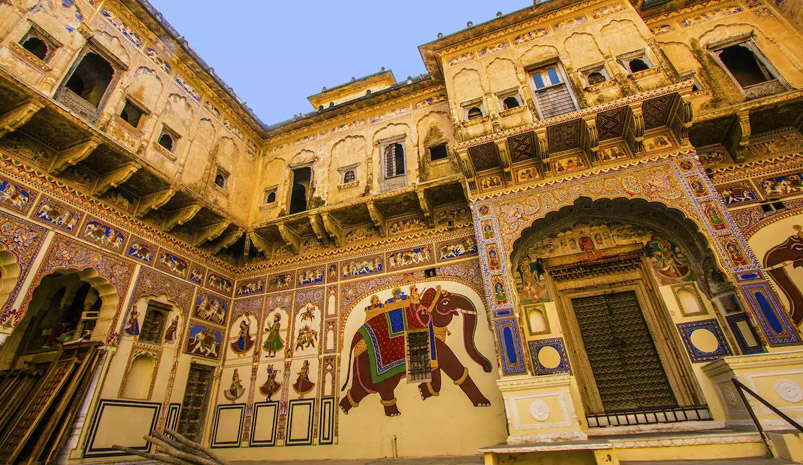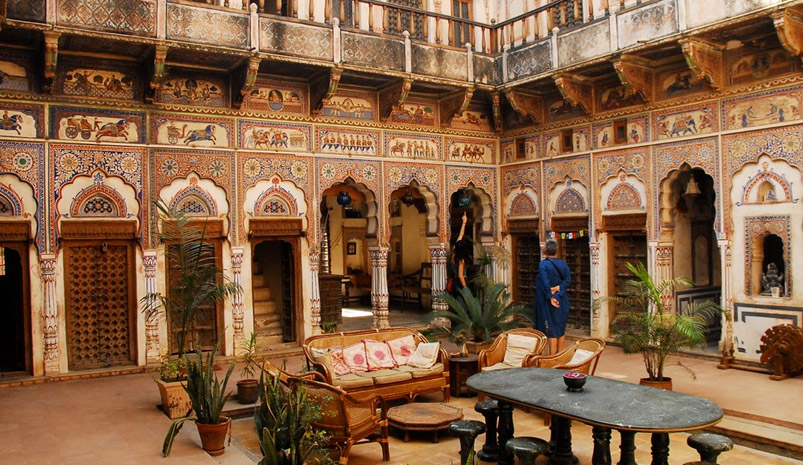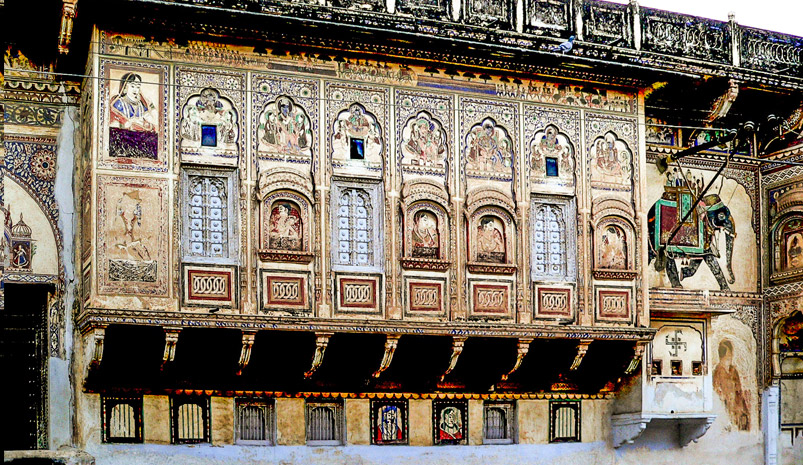Shekhawati
Shekhawati is a region located in the northeastern part of Rajasthan, India. It is known for its rich cultural heritage, stunning havelis (mansions), and exquisite frescoes. Here are some popular destinations within Shekhawati:
- Mandawa: Mandawa is one of the most visited towns in Shekhawati. It is renowned for its beautifully painted havelis, showcasing intricate frescoes depicting mythological scenes, historical events, and everyday life. The Mandawa Fort, now converted into a heritage hotel, is another prominent attraction.
- Nawalgarh: Nawalgarh is known for its opulent havelis adorned with frescoes and ornate architecture. Some of the famous havelis in Nawalgarh include Morarka Haveli, Poddar Haveli, and Aath Haveli. The town also has a rich history and is home to the Roop Niwas Palace, which has been converted into a heritage hotel.
- Fatehpur: Fatehpur is a small town in Shekhawati and is famous for its grand havelis and temples. The Haveli Nadine Le Prince, Haveli Devra, and Goenka Haveli are among the notable attractions. The town also has an impressive stepwell called Bissau Ka Chowk, showcasing architectural brilliance.
- Jhunjhunu: Jhunjhunu is the largest town in the Shekhawati region and serves as an important hub. It boasts several havelis with exquisite frescoes, such as Khetri Mahal, Badalgarh Fort, and Kaniram Narsinghdas Tiberwala Haveli. The Rani Sati Temple, dedicated to the deity Rani Sati, is a major pilgrimage site in Jhunjhunu.
- Dundlod: Dundlod is a quaint village in Shekhawati, known for its royal heritage and well-preserved havelis. The prominent attractions include the Dundlod Fort, adorned with magnificent paintings and antique furniture, and the Jagathia Haveli, famous for its frescoes and architecture.
Visiting these destinations in Shekhawati offers a glimpse into the region’s rich cultural heritage and architectural marvels. The intricate frescoes, ornate havelis, and historical sites make Shekhawati a must-visit destination for history and art enthusiasts.
History
Shekhawati region has a rich and fascinating history that dates back centuries. It was named after Rao Shekha, a Rajput ruler who founded the Shekhawati dynasty in the 15th century. The region flourished under the patronage of wealthy merchants who built magnificent havelis adorned with intricate frescoes. These havelis served as a symbol of the merchant’s prosperity and showcased their artistic sensibilities. Shekhawati was an important center of trade and commerce along the Silk Route, connecting India with Central Asia. The region’s history is reflected in its ornate havelis, forts, temples, and stepwells, providing a glimpse into the opulence and cultural heritage of the bygone era.
Geography
Shekhawati is a semi-arid region located in the northeastern part of Rajasthan, India. It covers an area of approximately 13,000 square kilometers. The region is characterized by undulating sandy terrain, interspersed with small hills and rocky outcrops. It lies between the Aravalli Range in the southeast and the Thar Desert in the northwest. Shekhawati is known for its hot and dry climate, with scorching summers and relatively cooler winters. The region receives limited rainfall, primarily during the monsoon season. Despite the aridity of the landscape, the region supports some vegetation, including thorny shrubs, desert plants, and scattered trees.
Weather
Shekhawati experiences a typical desert climate characterized by hot summers and relatively cooler winters. Here’s an overview of the weather in Shekhawati:
Summer (April to June): Summers in Shekhawati are scorching hot, with temperatures soaring as high as 45°C (113°F) or even higher. The region experiences intense heat and dry weather during this time. It is advisable to stay hydrated, wear light and breathable clothing, and avoid venturing out during the peak daytime hours.
Monsoon (July to September): Shekhawati receives limited rainfall during the monsoon season. The region experiences occasional showers that provide some relief from the summer heat. However, the amount of rainfall can vary from year to year, and the region may also experience drought-like conditions during certain years.
Autumn (October to November): Autumn in Shekhawati brings relatively cooler temperatures compared to summer. The weather starts becoming pleasant, with temperatures ranging from 25°C to 35°C (77°F to 95°F). It is a good time to visit as the weather is more comfortable for outdoor activities and sightseeing.
Winter (December to February): Winters in Shekhawati are generally mild and pleasant, with temperatures ranging from 10°C to 25°C (50°F to 77°F). However, nights and early mornings can be chilly, with temperatures dropping to around 5°C (41°F) or lower. It is advisable to carry some warm clothing, especially for the evenings.
Overall, the best time to visit Shekhawati is during the winter season (December to February) when the weather is relatively cooler and more enjoyable for exploring the region. However, if you can tolerate the heat, autumn (October to November) can also be a good time to visit. It’s advisable to check the weather forecast before your trip and pack accordingly to ensure a comfortable and enjoyable experience in Shekhawati.
How to reach
Shekhawati can be reached through various modes of transportation. Here are the common ways to reach Shekhawati:
By Air: The nearest airport to Shekhawati is Jaipur International Airport, located approximately 150 kilometers away. From the airport, you can hire a taxi or take a pre-booked car to reach your desired destination in Shekhawati.
By Train: The major railway station near Shekhawati is in Jaipur, which is well-connected to major cities in India. From Jaipur, you can take a taxi, hire a car, or use public transportation to reach Shekhawati.
By Road: Shekhawati is well-connected by road, and you can reach the region by buses, taxis, or private cars. National Highway 11 connects Shekhawati to major cities like Jaipur and Delhi. Several state-run and private buses operate regular services to Shekhawati from nearby towns and cities.
By Car: If you prefer a more flexible and convenient mode of transportation, you can drive to Shekhawati using your own vehicle or a rented car. The roads are well-maintained, and driving offers the freedom to explore the region at your own pace. However, make sure to have a valid driver’s license and familiarize yourself with the traffic rules and regulations.
Once you reach Shekhawati, it is advisable to hire a local taxi or auto-rickshaw for getting around and exploring the various towns and attractions within the region. Local transportation options are readily available, and drivers are often familiar with the popular destinations and routes.
It’s recommended to plan your travel in advance, check for any travel advisories or restrictions, and consider the distance and travel time from your starting point to Shekhawati.
Getting Around
Getting around Shekhawati can be done through various modes of transportation. Here are the common ways to navigate the region:
Auto-rickshaws and Cycle-rickshaws: Auto-rickshaws and cycle-rickshaws are popular modes of transportation for short distances within towns and cities in Shekhawati. They are readily available and offer a convenient and affordable way to explore the local areas. Negotiate the fare before starting the journey or ask the driver to use the fare meter.
Taxis and Private Cars: Hiring a taxi or a private car is a comfortable option for getting around Shekhawati, especially if you want to visit multiple destinations or travel with a group. You can either hire a taxi with a driver or rent a car for self-driving. It is advisable to book through authorized agencies or use reputable taxi services to ensure safety and reliable service.
Local Buses: Local buses operate within towns and connect neighboring villages in Shekhawati. They are an economical mode of transportation, but the frequency and availability of buses may vary. Inquire about bus routes and timings at the local bus stand or ask locals for information.
Walking: Shekhawati is known for its architectural heritage and intricately painted havelis. Walking is a great way to explore the towns and admire the stunning artwork on the havelis. Many of the major attractions in Shekhawati are located within walking distance of each other, allowing you to soak in the charm and beauty of the region at a leisurely pace.
It’s important to note that public transportation options may be limited in some rural areas of Shekhawati, so it’s advisable to plan your itinerary accordingly. It’s also recommended to carry a map, guidebook, or use navigation apps to help you navigate and locate the places of interest.
While getting around Shekhawati, always negotiate fares in advance, clarify the route with the driver, and keep small denominations of cash for payments. Respect local customs and dress modestly when visiting religious sites or conservative areas.





